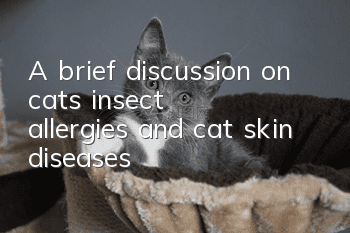A brief discussion on cats’ insect allergies and cat skin diseases!

Cats may be bitten by mosquitoes while playing in the grass
A brief discussion of cats’ insect allergies and cat skin diseases! Insect allergies are also common skin diseases in cats, and mosquito bites are also common skin diseases in cats. One of the reasons is that cats often play in the grass outside or dig through some trash cans. These places will harbor some insects. If the cat comes back with small bumps on its body, keeps scratching it, or has a swollen patch, then It may be an allergy that occurs after being bitten.
Symptoms of insect allergy in cats include maculopapular rashes and persistent itching on the skin, which appear suddenly and occur in areas such as the abdomen, knees, ventral chest, armpits, Some chronic ones can also cause hair loss and other symptoms on the face and limbs. Here are some common insects that cause skin allergies in cats.
1. Mosquitoes
Mosquito bite allergy usually occurs seasonally (in summer). Mosquitoes often bite the skin of cats with sparse hair, so the lesions are most severe. It often appears on the back of the nose, the skin in front of the ears, and even on the pads of the feet. The initial lesions are erythema or red and swollen papules, which gradually develop into erosion, ulcer, necrosis and covered with scab. More chronic lesions may include nodules, color changes (melanoderma or vitiligo), hair loss, or scaling. Acute cases sometimes present with symptoms of lymphadenopathy and fever.
It is worth noting that cats may develop heartworm disease when bitten by mosquitoes. Mosquito bites are the main way to spread feline heartworm disease. The only time of year when new infections are likely to occur is when mosquitoes A lot of the time. When a mosquito bites a cat, it injects a small amount of saliva into the bite, and the parasite is small and can invade into a small wound. From here it migrates into the body through the blood. Once it enters the body, it begins to develop quickly and then infects other places.
Once the larvae mature, they release microfilariae (the next generation of larvae) into the bloodstream. These larvae mature and begin their own life cycle. Bugs tend to get into many body tissues, so cats can become infested. The most common symptoms of feline heartworm disease are asthma and chronic vomiting, shortness of breath, coughing, decreased activity, mouth breathing, and gum discoloration (cyanosis, or blue).
So prevention is very important. Since mosquitoes are the main culprit in transmitting cat heartworms, you should try your best to prevent and eliminate mosquitoes in your home.
We do not have drugs to control the adult worms of cat heartworms, but there are drugs to prevent and control the microfilariae of heartworms. Oral drugs include Maoxinbao, etc., and skin drops can be used in large quantities. Be pampered and use it once a month.
2. Bee and Ant Allergy
Allergies caused by stinging insects can be further subdivided into four categories:
(1) Small-scale local reactions caused by injected toxins
(2) Large-scale local reactions caused by type 1 allergic reactions
(3) Systemic type 1 allergic reaction
(4) Systemic poisoning reaction caused by injection of a large amount of venom (such as being attacked by a large number of insects), which can be fatal in severe cases. Diagnosis is based on the presence of pinpricks of insects on the animal.
In most cases, when a cat is stung by a bee, the first step is to evaluate whether the dog has serious complications from the sting. Common minor symptoms include local swelling, redness, pain, etc., which are not serious. Severe symptoms include general swelling, hives, difficulty breathing, vomiting, diarrhea, and shock. You need to see a doctor immediately. In addition, if you find that your cat has been stung, be sure to carefully check whether there are multiple stings on the body. , because the more times you are stung, the greater the chance of severe symptoms.
After being stung, you can prepare an ice pack or wrap ice cubes in a towel to apply a cold compress to the stung area. Cold compresses can paralyze the nerves and can also reduce the cat’s pain and swelling. , pay attention to apply for 5 minutes and wait for 5 minutes to prevent the cat from frostbite. It is best to apply ice repeatedly until the swelling subsides. In addition, don’t forget to put a collar on the cat before the swelling subsides.
If severe swelling or hives occur, you need to contact your veterinarian to inquire about the use of some over-the-counter antihistamines (such as diphenhydramine) to reduce your cat's allergic reaction.
The second is acute allergic reactions caused by arthropods. Cats will also get red envelopes when bitten by ants. You can apply alkaline water to the affected area. Cats have also been reported to have similar symptoms due to exposure to spiders. The lesions are very acute and turn into small hemorrhagic papules within a short period of time. Or the nodules turn into lesions with severe bleeding, ulcers, and scabs; the distribution area is the nose, nose, and other parts with less hair. The onset of symptoms occurs within 24 to 72 hours after exposure to the pathogen, and the course of the disease lasts for about 1 week, and can cause hemolysis and hematuria.
Allergies caused by insect bites in cats need to be distinguished from other diseases, such as food allergies, hereditary allergies, and secondary bacterial infections. The clinical manifestations of these diseases are very similar, and doctors need to be careful during the diagnosis process. Identify carefully.
- The cat lost the trick to find the cat
- Is cat rhinoplasty contagious?
- Cats must not eat these things
- Management and health care of cats with anxiety and depression, a must-read for novice cat owners!
- What are the necessary common medicines for raising pet cats?
- What to do if a cat is picky about food How to correct the bad habit of picky eating
- Why can’t cats eat salt?
- How to rub a cat’s belly to help defecate
- What should I do if my cat is injured and loses a piece of skin?
- What can I eat to increase a cat’s resistance?



